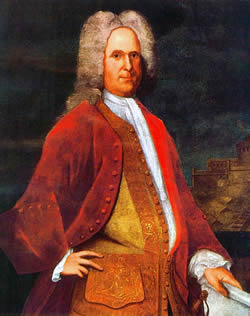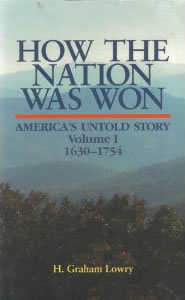September 4 - 10, 1716
Sic Juvat Transcendere Montes
Spotswood and His Knights of the Golden Horseshoe Reach the Shenandoah River
August 2011
 Portrait of Alexander Spotswood (1676–1740) by Charles Bridges, painted in 1736.. |
On Sept. 6, 1716, a major exploring expedition led by Virginia's Governor Alexander Spotswood succeeded in crossing the supposedly impassable Blue Ridge Mountains, and reached the west bank of the Shenandoah River. The expedition was not favored by the British Crown, nor by Virginia's Tidewater planters, but Spotswood was determined to break through the mountains to develop America's western lands, and to challenge Britain's tacit support for the devastating Indian warfare hurled at the American colonies from the French base in Canada.
As he later wrote to the hostile Board of Trade in London: "The Chief Aim of my Expedition over the great Mountains in 1716, was to satisfy my Self whether it was practicable to come at the [Great] Lakes. Having on that occasion found an easy passage over the great Ridge of Mountains, which before were judged Unpassable, I also discovered, by relation of Indians who frequent those parts, that from the pass where I was, It is but three Days' march to a great nation of Indians living on a River which discharges itself into Lake Erie." Thirty-seven years later, young George Washington, the son of one of Spotswood's ironmaking allies, would prove that statement to be true, when he ascended the Allegheny River on his mission to the French Commander at Fort Le Boeuf in today's western Pennsylvania.
Governor Spotswood, a skilled geometer and mathematician, as well as a former military commander, had prepared long and well for his historic expedition. Since assuming the governorship in 1710, he had pulled Virginia out of its colonial stupor, where it existed only to export tobacco to Britain, by designing Williamsburg as a beautiful capital, building roads into the interior, setting up a postal service, and establishing an iron industry. In his later capacity as Postmaster General for the colonies, it was Spotswood who appointed Benjamin Franklin as Postmaster of Philadelphia. And, as Virginia's leading proponent of developing new ironmaking techniques, the Governor became closely linked to Augustine Washington and his Accokeek Furnace. The Washington family maintained its ties to ironmaking and to settling the lands beyond the mountains until well after the Revolution.
From his earliest days in Virginia, Spotswood had formed a company of rangers to explore the colony and inventory its resources, and he often accompanied them to chart the waterways and select promising sites for new towns. By the end of 1710, the rangers had found iron deposits near the falls of the James River, and Spotswood proposed that the Crown sponsor the development of an iron industry. When he was refused, he used his own funds, and contacts with republican networks in Europe, to bring in German miners and settle them in western Virginia. His first iron works were known as Germanna.
Then, in June of 1716, Spotswood informed the Virginia Council that his rangers had found a pass over the Blue Ridge, where even supply trains could cross. The governor therefore recruited a "company of gentlemen," to prove that the Blue Ridge could be easily crossed. Many of these recruits had sons and grandsons who played important roles in the development of the American Republic. Among them was George Mason, whose son worked with George Washington to draft the Fairfax Resolves, and who designed much of the constitution of the new state of Virginia. Then there was James Taylor, the ancestor of two Presidents—James Madison and Zachary Taylor. Robert Brooke's grandson became governor of Virginia in 1798, and Thomas Todd's family helped secure Kentucky for the Americans during the Revolution, and produced a future First Lady for Abraham Lincoln.
Governor Spotswood led his expedition out of the capital at Williamsburg on Aug. 20, and rode to his ironworks at Germanna, where the group was to join two companies of rangers. There, Spotswood had both the pack horses and riding horses shoed with iron for the journey over the mountains. Up until this time, Virginians had ridden their mounts unshod, because there was little domestic iron and the Tidewater Area had gentle, sandy terrain. The governor wanted to make the point that iron was not only necessary for crossing the mountains, but that it was essential for settlers who would tame the wilderness beyond.
The exploring party crossed the Blue Ridge easily and discovered a major river on the other side. On Sept. 6 they crossed it, and Alexander Spotswood named it the Euphrates, invoking the memory of Alexander the Great, who had crossed the Euphrates to bring the Greek civilization of Plato's Academy to the eastern shore of the Mediterranean. Spotswood knew he was making history, and he came prepared for a major celebration. At that night's feast along the river, glasses were raised in toast after toast, accompanied by musket-fire salutes. The party drank "Virginia red wine and white wine, Irish usquebaugh, brandy shrub, two sorts of rum, champagne, canary, cherry, punch, cider, etc.," as recorded by one of the jolly participants.
After the return to Williamsburg, Spotswood lost no time in expanding Virginia's iron industry, and he was soon bringing in 80 more German immigrants, at his own expense, to set up the Tubal Furnace 13 miles from Germanna. And he presented to his fellow explorers, now dubbed the "Knights of the Golden Horseshoe," miniature golden horseshoes to commemorate the celebrated occasion. On these mementos was inscribed the Latin phrase, "Sic juvat transcendere montes," which translates as "Thus we crossed the mountains." And thus we did cross, and the forges and iron foundries and steel mills of Pittsburgh and Wheeling and Marietta testify that Spotswood had planned well.
Note: This report is based on material from "How the Nation Was Won," by H. Graham Lowry (Executive Intelligence Review; 1988).
The original article was published in the EIR Online’s Electronic Intelligence Weekly, as part of an ongoing series on history, with a special emphasis on American history. We are reprinting and updating these articles now to assist our readers in understanding of the American System of Economy.

 Click for more information
Click for more information